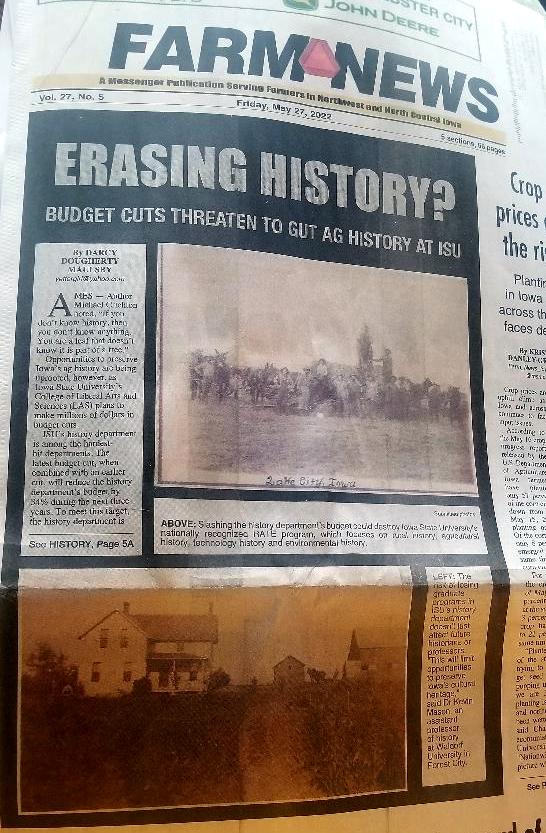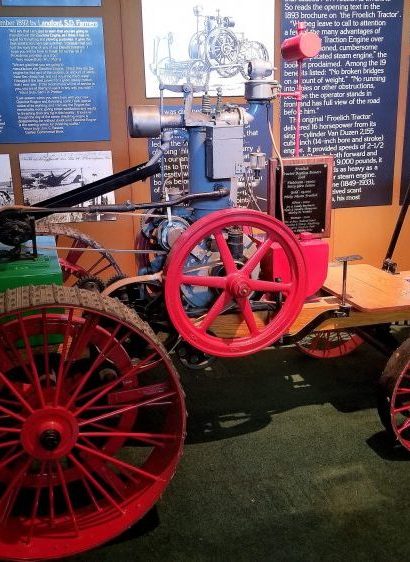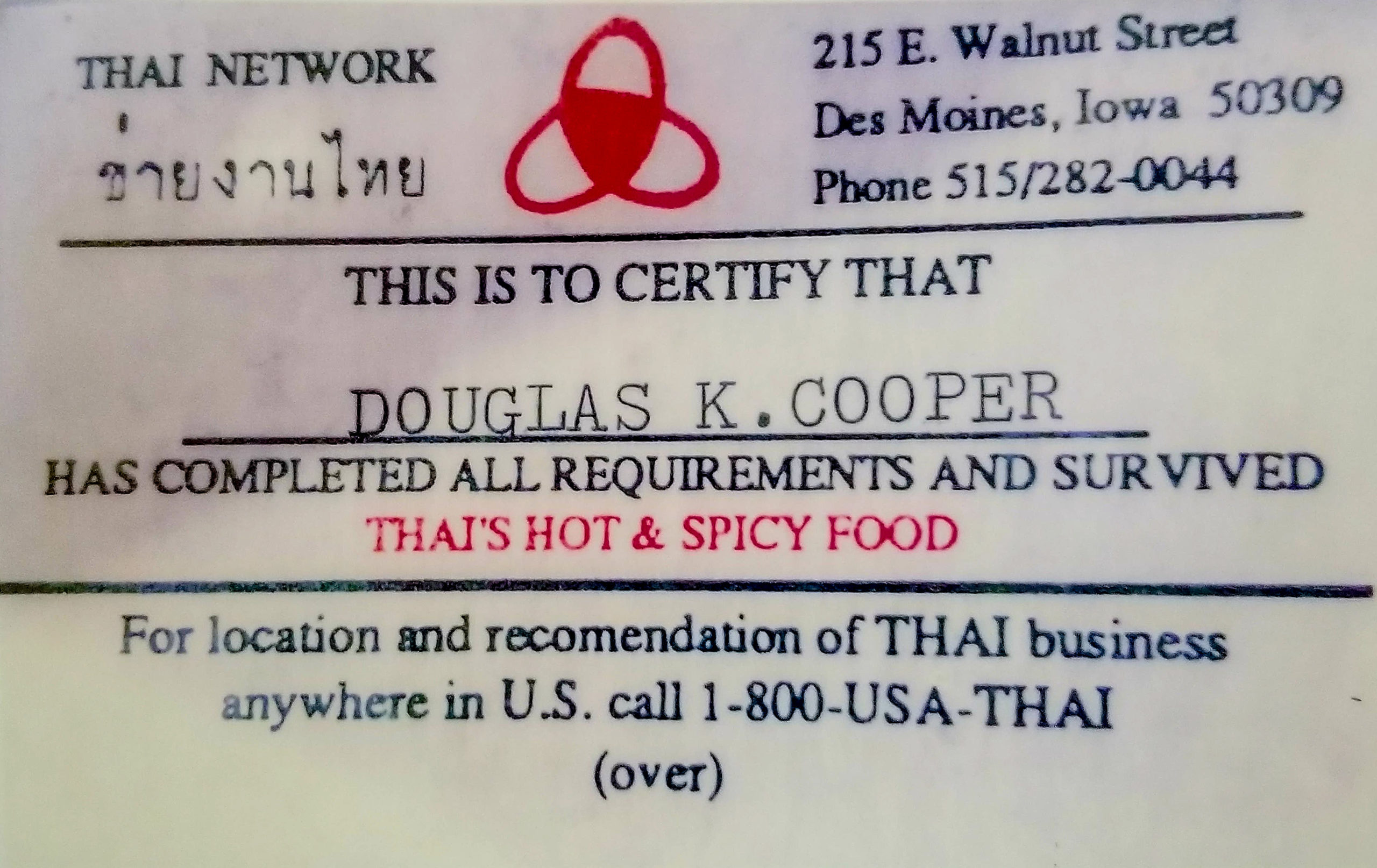
Whats HOT
Latest Posts

Finding Your Voice: The Story You Never Knew About “I Have a Dream”
Why do we still remember the powerful words of Martin Luther King Jr.’s “I Have a Dream” speech? Because he skipped the script.
The night before the speech, Tuesday, August 27, 1963, seven people, including Clarence Jones, a speechwriter, gathered with King at the Willard Hotel in Washington, D.C., to add their input to the final speech. King asked Jones to take notes and to turn them into cohesive remarks he would deliver on the steps of the Lincoln Memorial the next day.
“I tried to summarize the various points made by all of his supporters,” Jones recalled. “It was not easy; voices from every compass point were ringing in my head.”
The next morning King’s speech was finished and copies were delivered to the press. Fast forward a few hours later, when King was delivering the speech. If you’ve seen the film footage, you’ll notice that King looked down a lot in the first part of the speech, because he was reading the text.
But by the seventh paragraph, something extraordinary happened.
King paused.
In that brief silence, Mahalia Jackson, a gospel singer and good friend of King’s, shouted “tell ‘em about the ‘dream.’” Few people heard her, although King did. He pushed the text of his prepared remarks to one side of the lectern. He shifted gears in a heartbeat, abandoning whatever final version he’d prepared.
King improvised much of the second half of the speech, including the “I have a dream” refrain. King rarely looks down in the second half of the speech. It’s because he’s not reading; he’s riffing, like a jazz musician. And it was nothing short of soul-stirring.
Find your authentic voice
How does this apply to you? If you want to inspire your listeners (or readers), consider your audience, without a doubt, but find your authentic voice as you share your story.
Ask yourself, “What is it about my topic that makes my heart sing?” The answer will reflect your authentic voice and will connect with your listeners on a deeper, more emotional, more unforgettable level. You never know the impact your words can have. You just might make history.
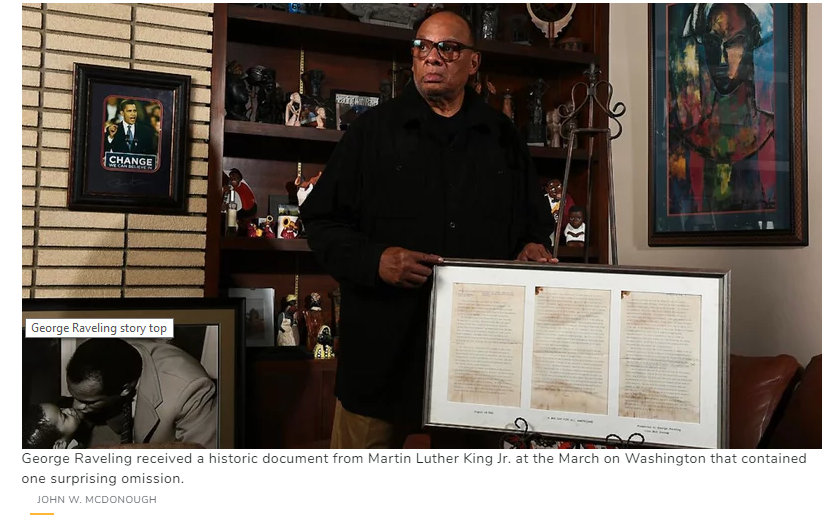
The story of how George Raveling, former men’s basketball coach at the University of Iowa, is intertwined with Martin Luther King Jr.’s famous “I Have a Dream” speech. Photo credit: Sports Illustrated
The Iowa connection
One more thing–there is a remarkable Iowa connection to this powerful story. It involves legendary basketball coach George Raveling, who coached men’s basketball at the University of Iowa in the 1980s. He has a copy of the famous speech, given to him by Martin Luther King, Jr. himself after the he delivered his immortal words on the steps of the Lincoln Memorial.
The story was retold in “Pioneering coach George Raveling’s surprising connection to MLK,” which ran in a 2015 issue of Sports Illustrated. Here’s a snippet:
“There is, however, one souvenir so special that Raveling stores it separately, at a secure location. The item is worth millions of dollars, but he will not sell it. It is too -important — to him, to his race and to his country.
Raveling acquired his most prized possession on Aug. 28, 1963, while standing on the steps of the Lincoln Memorial. Perhaps you recall what occurred on that date at that place: the March on Washington for Jobs and Freedom, the demonstration that culminated in a defining moment for the civil rights movement. Raveling didn’t decide to go to the march until two days before, yet he emerged from that trip with the three pieces of paper that lay on the podium while the final speaker delivered one of the most important addresses in U.S. history.
To understand how Raveling ended up next to the speaker, and why he refuses to cash in on his priceless memento, you have to rummage through his collection, run your finger along the road map and piece together the parallel lives of two men, one a preacher, the other a coach. Theirs is a story of history and happenstance, linked by a surreal moment that sprang from a dream.”
Read the rest of the story–and the all-important Iowa connection–here.
Want more?
Thanks for stopping by. I invite you to read more of my blog posts if you value intriguing Iowa stories and history, along with Iowa food, agriculture updates, recipes and tips to make you a better communicator.
If you like what you see and want to be notified when I post new stories, be sure to click on the “subscribe to blog updates/newsletter” button at the top of this page, or click here. Feel free to share this with friends and colleagues who might be interested, too.
Also, if you or someone you know could use my writing services (I’m not only Iowa’s storyteller, but a professionally-trained journalist with 20 years of experience), let’s talk. I work with businesses and organizations within Iowa and across the country to unleash the power of great storytelling to define their brand and connect with their audience through clear, compelling blog posts, articles, news releases, feature stories, newsletter articles, social media, video scripts, and photography. Learn more at www.darcymaulsby.com, or e-mail me at yettergirl@yahoo.com.
If you’re hungry for more stories of Iowa history, check out my top-selling “Culinary History of Iowa: Sweet Corn, Pork Tenderloins, Maid-Rites and More” book from The History Press. Also take a look at my latest book, “Dallas County,” and my Calhoun County” book from Arcadia Publishing. Both are filled with vintage photos and compelling stories that showcase he history of small-town and rural Iowa. Order your signed copies today! Iowa postcards are available in my online store, too.
Let’s stay in touch. I’m at darcy@darcymaulsby.com, and yettergirl@yahoo.com.
Talk to you soon!
Darcy
@Copyright 2019 Darcy Maulsby & Co. Blog posts may only be reprinted with permission from Darcy Maulsby.

Stop Rumors Before They Ruin Your Brand
Seriously–how does this stuff get started?
Like many of you, one of my goals for 2019 has been to focus on wellness, and that includes more exercise. Since options are limited here in snowy, cold Iowa in the winter, I’m glad there’s an indoor swimming pool nearby that’s open to the public a few hours a day.
I was swimming with some of my friends this morning, and one of them asked, “Have you sent that email yet?” I didn’t know what she was talking about, and she said she’s trying to encourage people who use the pool to let the facility’s administrator let know how much the community values the pool and how we don’t want it to close.
Turns out there’s a rumor swirling around that the cost of maintaining the pool might be prompting people in charge of the facility to close the pool. Distressing information, indeed.
I was glad when another one of my friends (one who works at the facility) stopped by to said hi while I was in the water. I asked if the talk about closing the pool was true.
“Where did you hear that?”
We told her the rumor was going around town. “No, this pool is important,” she said. “We have no plans to close it down.”
Not only was I relieved, but I started thinking about another conversation I had at the pool this morning. One of my friends brought up the name of the administrator of a large organization in town–but she admitted she wasn’t sure what the lady’s name was. Smith? Jones? Not sure.
All of us in the pool agreed that we knew little about this person. We also agreed how important it is for an organization (and those who lead it) to remain visible and keep the lines of communication open.
I wonder how many rumors, snippets of misinformation and flat-out lies could be countered effectively if people–especially business leaders–would stay in touch regularly with employees, customers, prospects, donors, the media and other key audiences. I’m not talking about a once-and-done approach, either.
In my experience, the best approach involves an ongoing commitment to sharing true stories well told through blog posts, e-newsletters, magazine articles, social media posts, videos and more) to add value for your audience. Along the way, you establish yourself as a trusted leader.
It’s an approach worth considering, especially in a world where a lie told often enough tends to become the truth.
Want more?
Thanks for stopping by. I invite you to read more of my blog posts if you value intriguing Iowa stories and history, along with Iowa food, agriculture updates, recipes and tips to make you a better communicator.
If you like what you see and want to be notified when I post new stories, be sure to click on the “subscribe to blog updates/newsletter” button at the top of this page, or click here. Feel free to share this with friends and colleagues who might be interested, too.
Also, if you or someone you know could use my writing services (I’m not only Iowa’s storyteller, but a professionally-trained journalist with 20 years of experience), let’s talk. I work with businesses and organizations within Iowa and across the country to unleash the power of great storytelling to define their brand and connect with their audience through clear, compelling blog posts, articles, news releases, feature stories, newsletter articles, social media, video scripts, and photography. Learn more at www.darcymaulsby.com, or e-mail me at yettergirl@yahoo.com.
If you’re hungry for more stories of Iowa history, check out my top-selling “Culinary History of Iowa: Sweet Corn, Pork Tenderloins, Maid-Rites and More” book from The History Press. Also take a look at my latest book, “Dallas County,” and my Calhoun County” book from Arcadia Publishing. Both are filled with vintage photos and compelling stories that showcase he history of small-town and rural Iowa. Order your signed copies today! Iowa postcards are available in my online store, too.
Let’s stay in touch. I’m at darcy@darcymaulsby.com, and yettergirl@yahoo.com.
Talk to you soon!
Darcy
@Copyright 2019 Darcy Maulsby & Co. Blog posts may only be reprinted with permission from Darcy Maulsby.
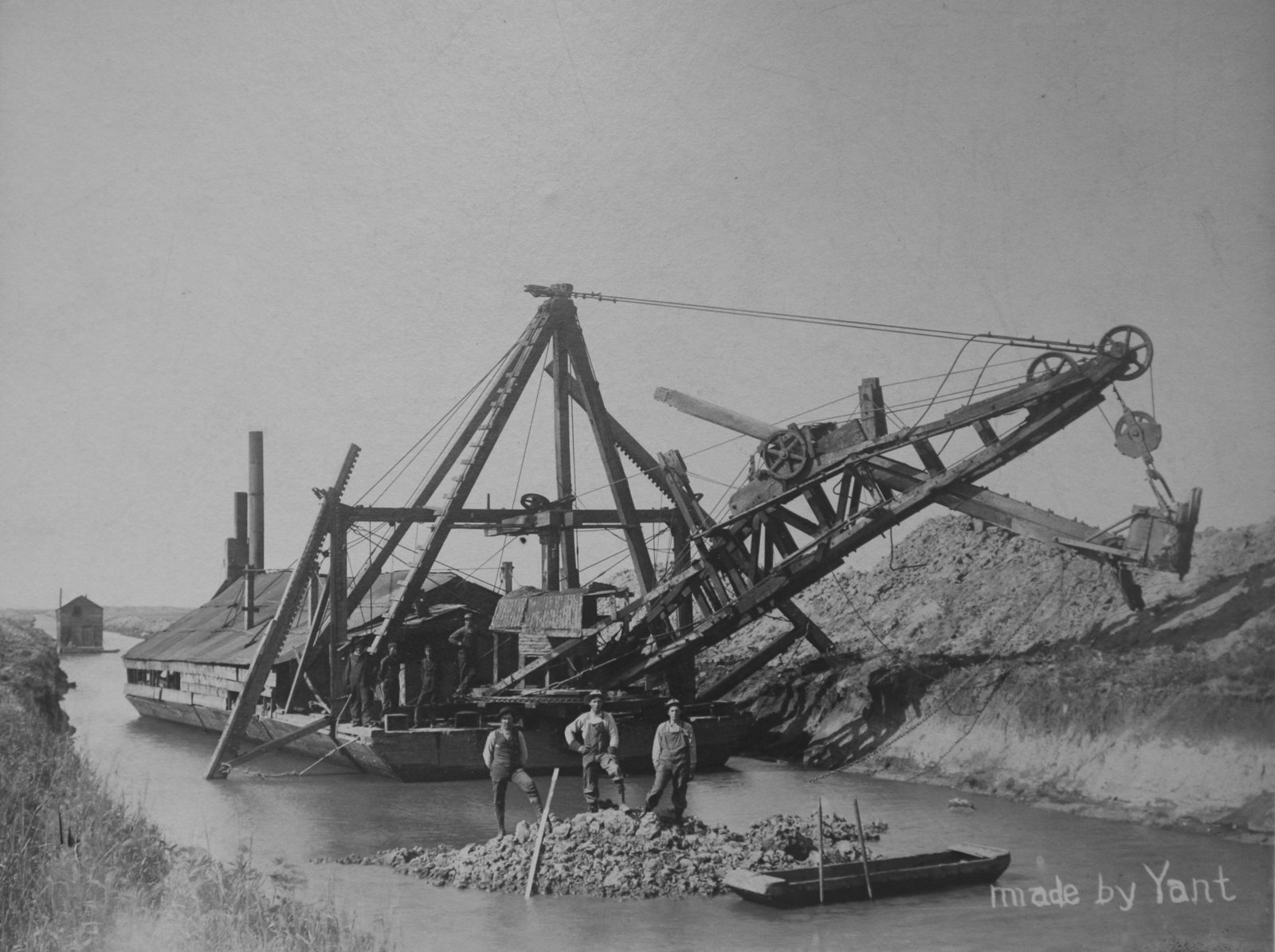
The Untold Story of Iowa’s Ag Drainage Systems
If there were a “Mysteries at the Museum” television series geared towards agriculture, this item would be ideal to lead in a segment. It’s hollow, it’s made of clay, it contains a message from the past, and it was buried in the ground for decades.
It’s a unique clay drainage tile dated 1885, and it’s on display in the Greene County Historical Society’s museum in Jefferson. The message carved around the exterior of the tile reads, “We the men who started the tile work did so with a motive to benefit the town and country. Signed T.P. LaRue of Scranton, Iowa.”
An interpretive sign by the tile shares a quote from S.J. Melson, a former Greene County engineer, to explain the curious item’s history. “This tile was placed into my hands by Carl Paup on February 1968. Mr. Paup stated the tile was unearthed and has lasted for many years on the property owned and operated by Harrison Paup of Kendrick Township, Greene County, Iowa.”
That tile reflects a major part of Iowa’s agricultural history that has been buried, literally, for generations, yet this history continues to influence farming methods, especially in the prairie pothole regions of north-central Iowa and northwest Iowa.
“In general, ag drainage in Iowa got its start around 1880, but this varied a lot, depending on the region,” said Joe Otto, a historian and Ph.D. candidate at the University of Oklahoma who works as a communications specialist with the Iowa Water Center at Iowa State University.
The first documented case of a drain tile being installed in Iowa occurred in 1868 on the grounds of Iowa State in Ames, Otto added. Before that, some of the first drainage ditches were dug in the 1850s along the Mississippi River in Des Moines County, just upstream from Burlington, so farmers could help protect themselves from flooding. One of these farmers, John Williams, was later elected to the state legislature and helped get the state’s first drainage laws passed in the 1870s, Otto said.
Drainage affected Iowa’s settlement patterns
Ag drainage was such a major issue in the 1800s that it impacted Iowa’s settlement. “Iowa wasn’t settled east to west, but from the bottoms up to the top of the state’s many river valleys,” Otto said. “Atop the river valleys were the flat, glaciated prairies of north-central and northwestern Iowa. These were settled and farmed starting in the 1870s and 1880s – several decades after farming started along the Mississippi.”
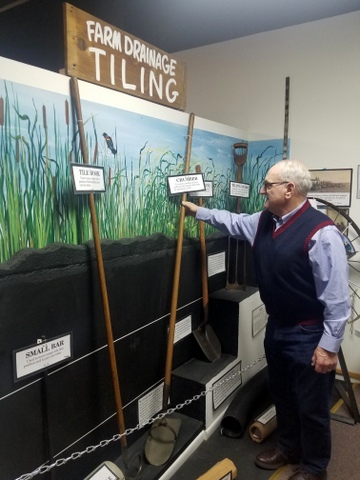
Jim Andrew revisits the exhibit designed by his father, James H. Andrew, a long-time Greene County farmer. This Farm Drainage Tiling exhibit is housed at the Greene County Historical Society’s museum in Jefferson, Iowa.
The region’s extensive swamps and sloughs were remnants of the last glacier, which loosened its icy grip on Iowa approximately 12,000 years ago. “There was a lot of water and nowhere for it to go,” Otto said. “Drainage ditches had to be dug and tile lines had to be laid before the sloughs and swamps of Iowa could be farmed. This started around 1880 and picked up speed in the early 1900s as drainage technology became more advanced.”
Ag leaders like Civil War veteran and pioneer farmer Jesse Allee, who settled in the Newell area in 1871, knew ag drainage would be essential to the development and prosperity of the region. “He was far-seeing with the unshakable belief in the future of the community’s farm land,” stated the 1969 Newell centennial history book on display at the Allee Mansion south of Newell. “Jesse worked hard educating the public to the necessity of proper drainage if this area was to be a leader in agriculture.”
Settlers in Greene County faced a similar situation. “By 1880, many landowners realized underground drainage tile was needed to remove the excess water,” wrote James H. Andrew, a long-time Greene County farmer who created the Farm Drainage Tiling exhibit at the Greene County Historical Society’s museum
in Jefferson before he passed away in 2014.
As more settlers moved into Iowa and demand for tile drainage grew, tile kilns and factories popped up across the state, Otto noted. Greene County, like many Iowa counties, had multiple firms manufacturing clay tile. These businesses used locally-sourced clay, including the Jefferson Cement Products Co., which was located just north of the Greene County Fairgrounds and operated until about 1930, and Lawton and Mass, which produced concrete tile at Cooper for a number of years, starting in 1895.
“There were also small machines made for farmers to mix concrete and scoop it into a manually-cranked device that used metal forms to make various sizes of tile,” wrote Andrew, who was known as “Mr. History.” “They advertised you could make your tile at home for half the cost of commercial tile. But it’s doubtful if this was very successful, since the proper steaming and curing of concrete tiles is important.”
Drainage districts take shape
Ag drainage in Iowa took a major leap forward in 1904, when state legislation provided for the formation of drainage districts. “Farmers could always drain their own lands if they wanted to, but to truly manage drained water meant cooperation with your neighbors,” Otto said.
A group of farmers could petition for a drainage district. An engineer would survey the land to establish the boundaries of the area, and a feasible drainage plan would be developed.
If approved, a contract would be drawn up, with the cost paid by assessing each landowner for his or her fair share, considering his needs and the acres involved. The county acted as the administrator of the drainage district and assessed taxes against the land, as needed, to pay for the initial cost and later for the maintenance of the drainage district. Many times, the money would be borrowed by issuing bonds, and the landowners would make payments on a 10-year plan, Andrew noted.
“The drainage district plan provided the larger tile needed for the main arteries of the system,” Andrew wrote. “Individual landowners were responsible for installing and paying for the lateral tile lines installed on their respective farms to complete the drainage plan.”
From 1904 to 1919, an average of 10 new drainage districts were created per year in Greene County. “That’s a new district about every five weeks,” Andrew wrote.
The 1910s became the golden age of ag drainage when most of Iowa’s public drainage systems were built, Otto added. “By 1912, Iowa’s farmers had spent more money on drainage then the U.S. government spent to build the Panama Canal.”
A Greene County drainage district created in 1916 to drain 998.7 acres using approximately 3.5 miles of tile ranging in size from 10 inches to 22 inches cost of $9,135, [more than $218,640 in today’s dollars], said Michelle Fields, drainage clerk for Greene County. “A drainage district created and installed in 2013 drained 865.5 acres using around 2.38 miles of tile ranging in size from 15 to 24 inches at a cost $532,500,” she added.
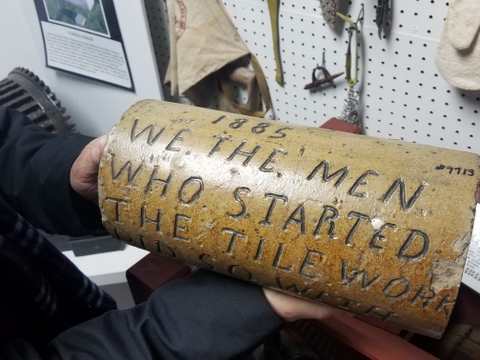
This unique clay ag drainage tile dated 1885 is on display in the Greene County Historical Society’s museum in Jefferson. The message carved around the exterior of the tile reads, “We the men who started the tile work did so with a motive to benefit the town and country. Signed T.P. LaRue of Scranton, Iowa.”
Recalling the life of a ditch digger
By 1920, the formation of ag drainage districts in Iowa slowed down as the post-World War 1 ag depression hit rural America. Still, the work continued.
“Steam power (and later gasoline) engines moved steel and iron machines that could move a lot more dirt around than could horse-drawn scrapers and plows,” Otto said.
Around 1923, after most Greene County drainage districts were in place, the first tiling machines started to be used, although hand digging continued for many years, Andrew noted. In the spring, summer and fall, men could find a job “in the ditch” if they wanted to work. “Many immigrants coming to the USA found their first jobs digging canals, and later drainage ditches. You didn’t have to know English to be a good man in the ditch,” added Andrew, who noted that many of these workers were from Sweden and Ireland.
The early tilers typically lived in tents or small, portable shacks next to the wet land they were draining. They often cooked their own meals and lived off the land by catching frogs for fried frogs’ legs and snapping turtles for turtle soup. They shot ducks, geese and rabbits for meat. Sometimes bullheads and other fish could be caught in the larger ponds, Andrew noted. For water, including drinking water, the men would take a post auger and dig a hole 3 to 4 feet deep and would set in an old farm pump.
“Ditch digging was well organized, and the men were paid by the rods of ditch dug by each man,” Andrew wrote. “No work—no pay. And of course, workmen’s compensation, health insurance and so on were unheard of.”
“Generous gifts”
By the 1970s, corrugated plastic pipe was introduced, which gradually phased out clay tile as the most efficient way to drain land. Today, Greene County has nearly 3,000 miles of drainage district tile and pipes, ranging from 4 inches to 48 inches in diameter. This distance would roughly equal a tile ditch spanning from New York to San Francisco.
“Note that the 3,000 miles is just a measure of the district tiles,” Fields said. “That number would be exponentially larger if you included private tile lines.”
As ag drainage issues have increasingly become intertwined with debates about conservation and water quality, it’s important to keep the line of communication open, Otto said.
“I think the harsh reaction against ag drainage that’s happened in the past few years is due in part to people suddenly wanting to engage in drainage matters, but unsure of what drainage is and does, who administers it and what powers they have. On the other side of the coin, the people trusted to manage the public’s interests in drainage have a responsibility to break down barriers, explain misconceptions and guide the conversation to a common ground.”
That’s a big reason why Andrew documented the history of ag tiling, counting it as one of the most important events in local history and the settlement of the region, noted his son, Jim Andrew of Jefferson.
“Think of the men and the effort it took to dig the clay, form and cure the tile, haul the tile to the jobsite, the survey crews working in ponds and swamps, the drainage plans made by the drainage engineer proving drainage was practical, the legal problems of objections and disputes, letting the bids, and, most important, the hundreds of men with strong backs who worked digging the ditches, laying the tile and filling the ditches,” wrote James H. Andrew.
“Yet, the tile is hidden underground, and the ‘Iron Men’ tilers are all deceased,” he concluded. “As time passes, there is little appreciation for the cooperative efforts that drained Greene County and made it so productive. Only when these old tile systems fail and have to be replaced at great expense will many people realize the generous gifts we’ve received from the drainage district system.”
Want more?
Thanks for stopping by. I invite you to read more of my blog posts if you value intriguing Iowa stories and history, along with Iowa food, agriculture updates, recipes and tips to make you a better communicator.
If you like what you see and want to be notified when I post new stories, be sure to click on the “subscribe to blog updates/newsletter” button at the top of this page, or click here. Feel free to share this with friends and colleagues who might be interested, too.
Also, if you or someone you know could use my writing services (I’m not only Iowa’s storyteller, but a professionally-trained journalist with 20 years of experience), let’s talk. I work with businesses and organizations within Iowa and across the country to unleash the power of great storytelling to define their brand and connect with their audience through clear, compelling blog posts, articles, news releases, feature stories, newsletter articles, social media, video scripts, and photography. Learn more at www.darcymaulsby.com, or e-mail me at yettergirl@yahoo.com.
If you’re hungry for more stories of Iowa history, check out my top-selling “Culinary History of Iowa: Sweet Corn, Pork Tenderloins, Maid-Rites and More” book from The History Press. Also take a look at my latest book, “Dallas County,” and my Calhoun County” book from Arcadia Publishing. Both are filled with vintage photos and compelling stories that showcase he history of small-town and rural Iowa. Order your signed copies today! Iowa postcards are available in my online store, too.
Let’s stay in touch. I’m at darcy@darcymaulsby.com, and yettergirl@yahoo.com.
Talk to you soon!
Darcy
@Copyright 2019 Darcy Maulsby & Co. Blog posts may only be reprinted with permission from Darcy Maulsby.
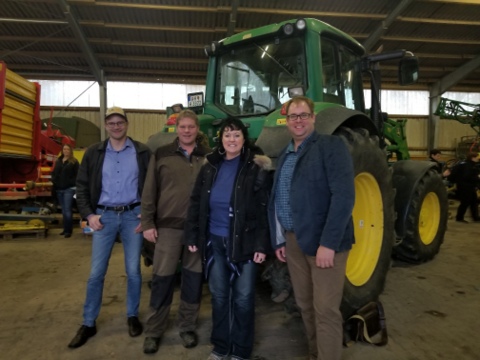
Ag-Vocating Worldwide: Top 10 Tips for Sharing Ag’s Story with Consumers
Any of these sound familiar? Many consumers today don’t understand modern agriculture. Activists are spreading misinformation about farming. Myths about farming seem to carry more weight than facts. I couldn’t believe what I was hearing. While these things are top of mind for me here in Iowa, they’re hot topics in Germany and across Europe, too.
So what do you do about it? We shared best practices when I joined five other ag leaders from Iowa in northern Germany to meet with European farmers, veterinarians and other ag professionals during the Transatlantic Agricultural Dialogue on Consumer Engagement from November 11-16, 2018.
“This experience highlighted why we must make time to share the what and why of how we do things on the farm,” said my friend Chad Ingels, a farmer from Randalia, Iowa, who participated in the Germany study trip, which was supported by the German-American Chamber of Commerce. “Consumers around the world really have no idea what happens in the day-to-day activities on the farm. We need to share our story and keep it simple, without using ‘farmer jargon.’”
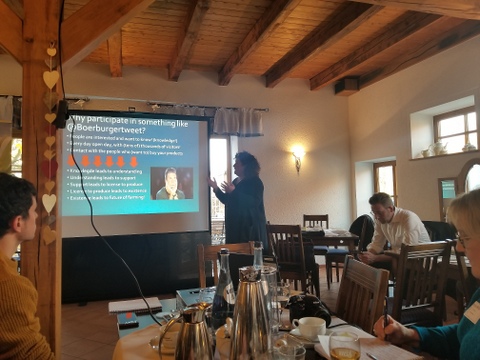
Learning practical tips in Germany for telling ag’s story effectively
Ingels, who raises corn, soybeans and hogs and is active on social media, appreciated the opportunity to exchange practical ideas to address the public’s questions about food production. During these discussions, ag leaders from both sides of the Atlantic shared their 10 top tips for engaging with consumers, including:
1. Be willing to engage. Who is telling agriculture’s story, and what are they saying? Don’t leave it to chance, said Caroline van der Plas from the Netherlands, who encourages farmers to build relationships and share their story with consumers, the media and lawmakers. “If you don’t share your story, others like People for the Ethical Treatment of Animals (PETA) will tell it for you,” said van der Plas, who coordinates the Dutch social media project @boerburgertweet, which allows farmers to share their story with consumers on Twitter.
The ripple effect from one story can be powerful, noted Janice Person, online engagement director for Bayer CropScience. She credits one interview more than 20 years ago with Louisiana farmer Ray Young for motivating her to pursue an agricultural communications career. “I was a city girl from Memphis who was interested in ecology,” said Person, keynote speaker at the Transatlantic Agricultural Dialogue on Consumer Engagement. “When I interviewed Ray Young, he had me so focused on his soils that I can still see them in my mind. He explained conservation tillage and helped me understand how he was getting it to work on his farm. By taking the time to tell his story, Ray helped me become an influencer for agriculture.”
2. Look at ag through consumers’ eyes. Empathy matters. People don’t care how much you know until they know how much you care, Person said. “Many people today are hearing things about food and agriculture that scare them. Sometimes people are angry, sometimes they are confused and sometimes they want to listen.” Most people just want what’s best for their families, added Person, who noted that farmers can bring a valuable, real-world perspective to the conservation.
3. Tell a different side of the story. While most consumers have heard a lot about organic farming, they rarely hear about other types of production. “It’s easy for people to think there’s only one side of the story or one way to farm, unless you share a different perspective,” Person said.
4. Focus on the moveable middle. Activists are loud, but they are still a minority, said Nadine Henke, an ag-vocate from Germany. “There are still a lot of people in the middle, but few really understand modern agriculture. We can reach out to them.”
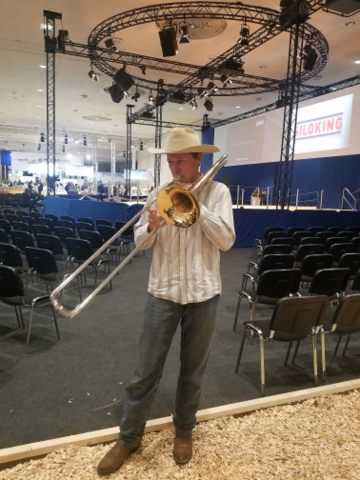
Farmer Derek from Kansas and his trombone, calling the cows
5. Find inspiring ag-vocates. There are many ag-vocates to follow online, from Dirt Sweat N Tears (@farmermegzz on Twitter), a film industry specialist turned farmer from Saskatchewan, Canada, to Derek Klingenberg (@Farmer Derek on Twitter), a Kansas farmer and rancher whose popular YouTube videos range from him playing his trombone to call his cows to a video of a college choir singing in his new grain bin. “We have different crops and livestock and various ways of farming, so our stories are all different,” Person said. “What ag-vocates have in common is their decision to tell their story and make a positive impact.”
6. Never underestimate face-to-face conversations. While social media gets a lot of attention, it’s not the only place to tell ag’s story, Person said. “Some of the most important conservations still take place in person.”
7. Show how technology can be part of the solution. “Most people like to be modern,” Person said. Share the story of modern ag by showing how technology is helping protect the environment with solutions like precision spraying. “People love to discover things,” Person said. “They don’t like to be lectured to. Sharing knowledge can create a sense of wonder.”
8. Stay on track. Challenge people and encourage them to think about a different viewpoint, but always be respectful of your audience, Person said. “Be careful about going on defense too soon. Also, make time to explain not just the how, but why you do what you do on the farm.” Don’t stop with posting pictures, she added. Share your stories of the land and what you think is special about your region. If you have livestock, explain the how and why of manure management. If you like to cook, showcase seasonal foods and recipes. In any case, don’t devote too much time to people who aren’t willing to listen and only want to argue, Caroline van der Plas added. “The longer you engage with activists, the less time you have to tell your story.”
9. Build trust. What’s the ultimate goal of telling ag’s story? Building trust. “It’s all relationship based, and trusted relationships are so important,” Person said.
10. Take the long view. Communication is never a once-and-done deal. It’s an ongoing process. “What can you do in the next year, and the next five years, to tell your ag story?” Person asked. Also, remember that you’re not alone. “Sometimes food and farming issues feel so polarized that it’s easy to forget other people are saying the same things we are,” Person said. “It’s incredibly rewarding to reach out with ag’s story. Know that there is power in coming together.”
So here I am back home in rural Iowa, trying to implement these 10 tips, starting with this article, which originally appeared in Farm News and the Fort Dodge Messenger. I’d love to hear from you, too. In your experience, what works well to share your story effectively?
Want more?
Thanks for stopping by. I invite you to read more of my blog posts if you value intriguing Iowa stories and history, along with Iowa food, agriculture updates, recipes and tips to make you a better communicator.
If you like what you see and want to be notified when I post new stories, be sure to click on the “subscribe to blog updates/newsletter” button at the top of this page, or click here. Feel free to share this with friends and colleagues who might be interested, too.
Also, if you or someone you know could use my writing services (I’m not only Iowa’s storyteller, but a professionally-trained journalist with 20 years of experience), let’s talk. I work with businesses and organizations within Iowa and across the country to unleash the power of great storytelling to define their brand and connect with their audience through clear, compelling blog posts, articles, news releases, feature stories, newsletter articles, social media, video scripts, and photography. Learn more at www.darcymaulsby.com, or e-mail me at yettergirl@yahoo.com.
If you’re hungry for more stories of Iowa history, check out my top-selling “Culinary History of Iowa: Sweet Corn, Pork Tenderloins, Maid-Rites and More” book from The History Press. Also take a look at my latest book, “Dallas County,” and my Calhoun County” book from Arcadia Publishing. Both are filled with vintage photos and compelling stories that showcase he history of small-town and rural Iowa. Order your signed copies today! Iowa postcards are available in my online store, too.
Let’s stay in touch. I’m at darcy@darcymaulsby.com, and yettergirl@yahoo.com.
Talk to you soon!
Darcy
@Copyright 2018 Darcy Maulsby & Co. Blog posts may only be reprinted with permission from Darcy Maulsby.
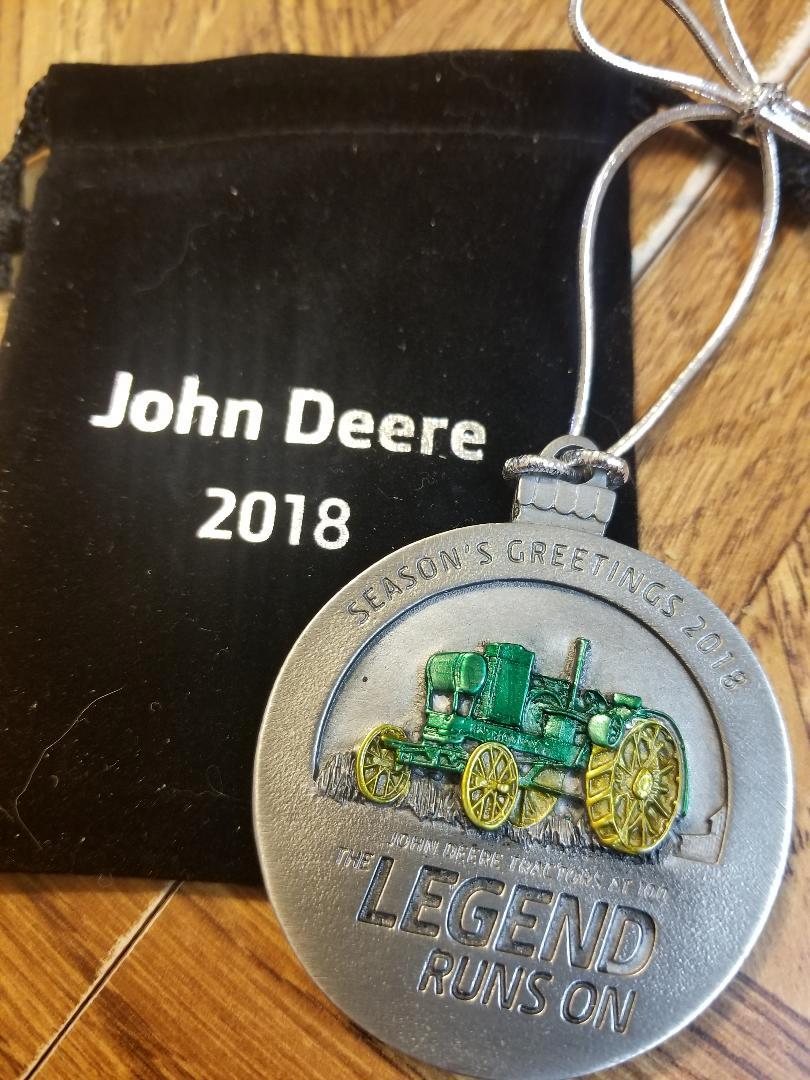
Butter Sculptures to Christmas Ornaments: Waterloo Boy Tractor Celebrates 100 Years
It’s hard to imagine a time when John Deere wasn’t a powerhouse in the tractor business. Yet, John Deere wouldn’t enter the farm tractor business until March 1918 through the acquisition of the Waterloo Gasoline Engine Company, and it’s a milestone that has been commemorated in everything from butter to Christmas ornaments.
Deere has featured a picture and story depicting the 100th anniversary of the iconic Waterloo Boy on its 2018 Christmas ornament. The 2018 Iowa State Fair also honored the tractor by featuring the world-famous Butter Cow beside a butter sculpture of the Waterloo Boy. Both butter masterpieces were displayed in the 114-year old John Deere Agriculture Building’s 40-degree cooler throughout the fair, which ran from August 9-19.
The Iowa State Fair has long been a prime venue to display Deere equipment in its various forms. A quote from the John Deere Sales Department in 1940 read, “I feel that the machinery and industrial exhibits for 1940 excelled any previous year’s display,” according to history shared by the Iowa State Fair. “We consider our Iowa State Fair exhibit to be a very beneficial part of our advertising program, and we will be with you again in 1941.’”
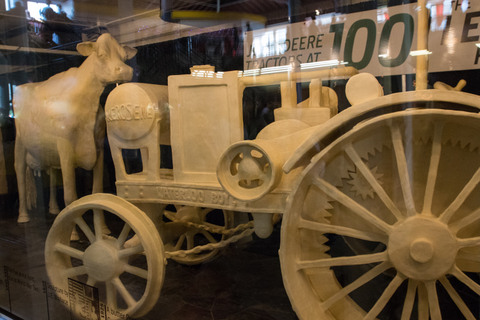
Waterloo Boy butter sculpture 2018 Iowa State Fair
Meeting the challenge of a reliable, durable tractor
Frequently ranked as one of the top events in the country, the Iowa State Fair is the single largest event in the state of Iowa and one of the oldest and largest agricultural expositions in the country and annually attracts more than a million people from all over the world.
In 2018, the Iowa State Fair used more than 50 John Deere tractors and utility vehicles provided by Van Wall Equipment. In addition, a 1919 Waterloo Boy model N tractor was on display in the Machinery Grounds at the Iowa State Fair.
To understand the significance of the Waterloo Boy, take a trip back in time, said Neil Dahlstrom, manager of the John Deere Archives and History. In the critical five-year stretch (1912-1917) prior to John Deere entering the tractor business, there were two key issues the company needed answered.
“First, what did farmers really want from a machine that would soon make the horse obsolete?” said Dahlstrom, who noted that salesmen, territory and branch managers, and Deere’s top leadership scoured the country to understand what customers desired.
Also, how could the equipment to be manufactured to be durable enough to stand up to daily farm use?
Deere had considered every imaginable idea. The company had developed one-, two- and four-cylinder concept tractors. Some ran on gasoline. Others ran on kerosene. Some had all-wheel drive. Others had front-wheel drive. The company even explored concepts like line steering, which was meant to replicate horse reins as the steering mechanism to ease farmers into power farming, Dahlstrom said.
A motorized cultivator, what Deere called a “Tractivator,” was brought to market by several competitors, but Deere determined it did not provide any cost savings compared to horses.
The challenge of producing a durable tractor loomed large. In a letter to company president William Butterworth in 1915, Deere’s superintendent of factories George Mixter noted that tractors offered by competitors up to that point “have not been built with the proper spirit behind the design and manufacture to insure their durability in the hands of the farmers.” But if Deere could “build a small tractor that will really stand up for five or more years’ work on the farm, I believe they will be a permanent requirement of the American farmer,” Mixter wrote.
Deere ultimately found the solution with the Waterloo Boy tractor and acquired the Waterloo Gasoline Engine Company in Waterloo, Iowa, on March 14, 1918. Although anxious to start selling the Waterloo Boy, Deere dealers had to wait while Deere honored existing contracts, which did not expire until Dec. 31, 1918, Dahlstrom said.
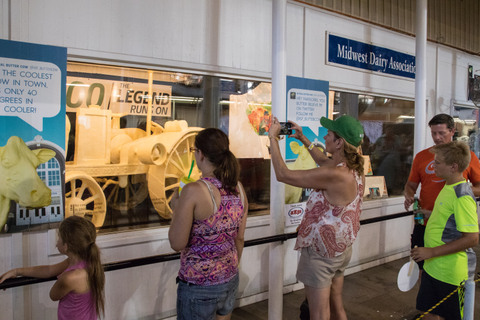
Visitors snapped photos of the iconic Waterloo Boy butter sculpture 2018 Iowa State Fair.
Waterloo Boy makes its debut
Deere put its money where its instincts were. Over the next year, the company spent more than one-third of its advertising budget touting the Waterloo Boy tractor, Dahlstrom said.
Specifically, Deere invested $50,000 on tractor advertising in the year following its debut of the Waterloo Boy—approximately $747,000 in today’s money. Another way to get the company’s new product out in front of customers was to take it on the road – literally.
The National Tractor Demonstrations started to become more mainstream after being introduced in the United States in 1913. An eight-city, eight-week tour schedule was the perfect opportunity to unveil Deere’s Waterloo Boy, Dahlstrom said. Salina, Kansas, served as the ideal backdrop in August 1918, since this was the nation’s largest demonstration.
Deere had participated in tractor demonstrations since the original Winnipeg Agricultural Motor Competitions in Manitoba, Canada, in 1908 – but not with a tractor. Instead, Deere had paired its plows with leading tractor manufacturers. That changed now that the Waterloo Boy was part of the Deere family.
At Salina, Deere spared no expense, showcasing 12 Waterloo Boy tractors as the centerpiece of a display that included John Deere signs, Waterloo Boy signs and a copper leaping deer statue, Dahlstrom said. “There were two stars during this week of 100-degree days – ‘ice water on tap’ and the Waterloo Boy Model ‘N’ tractor,” he added.
The Model “N” demonstrated its merits by pulling tractor plows, disc harrows and grain drills. Visitors were shuttled in three John Deere farm wagons pulled by Waterloo Boy tractors. By all accounts, the debut was a success.
“The award for the most elaborate, largest and most artistic exhibit tent at the Salina tractor show will undoubtedly go to the John Deere Plow company of Kansas City,” wrote the editors of a Kansas City newspaper.
As Deere’s advertising campaign swung into full gear, the Waterloo Boy tractor was promoted as the “best and most efficient tractor” on the market for farmers inclined to buy a tractor. By October 1918, readers of Deere’s magazine, The Furrow, saw an advertisement for the line of Waterloo Boy tractors and stationary engines. The ad guaranteed the Waterloo Boy’s “ample power for field and belt work.”
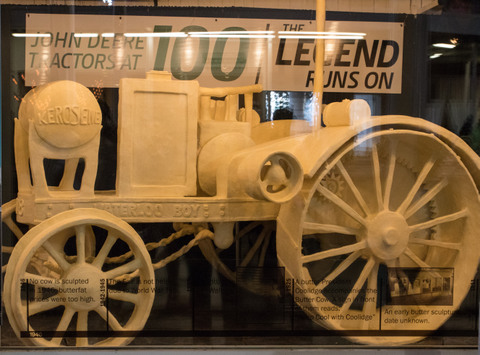
Waterloo Boy butter sculpture 2018 Iowa State Fair
In January 1919, with tractors now available through John Deere dealers, Deere’s first print ad for the trade press appeared in The Farm Implement News. It featured two areas of emphasis: “A Good Tractor Backed by a Permanent Organization.”
After years of development, John Deere customers and John Deere dealers finally had their John Deere tractor.
“It took longer than the company expected, but a determination to do it right instead of doing it fast now brought the John Deere tractor to market,” Dahlstrom said.
As a result, customers got “the assurance of more tractor work per dollar of fuel cost; longer tractor life with less repair cost; accessibility of parts that makes caring for the tractor simple and easy; and dependable power for all farm work.”
The tractor era had officially arrived.
Want more?
Thanks for stopping by. I invite you to read more of my blog posts if you value intriguing Iowa stories and history, along with Iowa food, agriculture updates, recipes and tips to make you a better communicator.
If you like what you see and want to be notified when I post new stories, be sure to click on the “subscribe to blog updates/newsletter” button at the top of this page, or click here. Feel free to share this with friends and colleagues who might be interested, too.
Also, if you or someone you know could use my writing services (I’m not only Iowa’s storyteller, but a professionally-trained journalist with 20 years of experience), let’s talk. I work with businesses and organizations within Iowa and across the country to unleash the power of great storytelling to define their brand and connect with their audience through clear, compelling blog posts, articles, news releases, feature stories, newsletter articles, social media, video scripts, and photography. Learn more at www.darcymaulsby.com, or e-mail me at yettergirl@yahoo.com.
If you’re hungry for more stories of Iowa history, check out my top-selling “Culinary History of Iowa: Sweet Corn, Pork Tenderloins, Maid-Rites and More” book from The History Press. Also take a look at my latest book, “Dallas County,” and my Calhoun County” book from Arcadia Publishing. Both are filled with vintage photos and compelling stories that showcase he history of small-town and rural Iowa. Order your signed copies today! Iowa postcards are available in my online store, too.
Let’s stay in touch. I’m at darcy@darcymaulsby.com, and yettergirl@yahoo.com.
Talk to you soon!
Darcy
@Copyright 2018 Darcy Maulsby & Co. Blog posts may only be reprinted with permission from Darcy Maulsby.
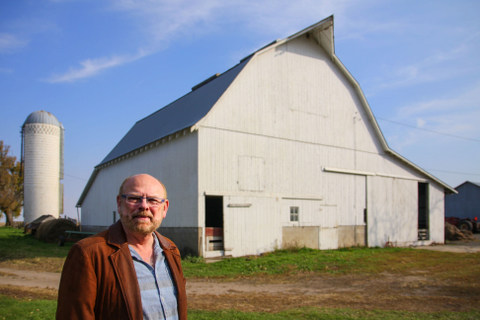
Barn Helped Inspire Master Craftsman to Create Dobson Pipe Organ Builders
When a sow kicked a heat lamp into the straw one cold January night in 1954 and burned down the barn on the Carroll County farm where Lynn Dobson’s family lived, no one imagined how much impact the blaze would have. It became a defining moment for Dobson, however, even though he was only four years old at the time.
“When the barn was rebuilt that summer, I wanted to be out working with the carpenters all the time,” said Dobson, founder of Dobson Pipe Organ Builders Ltd. of Lake City, which constructs fine pipe organs for churches, universities and other clients. “The carpenters told my mom they didn’t mind, and they even gave me small tools to ‘work’ with, including a hammer and screwdriver.”
Once the Wilson brothers from Farnhamville completed the new barn, they were hired each summer to work on other construction and remodeling jobs for various outbuildings at the Jasper Township farm. “These construction projects were a highlight of growing up on the farm,” said Dobson, who also learned carpentry skills from his father, Elmer, who was a cabinetmaker as well as a farmer. “My imagination was fired up.”
“They feel like cathedrals”
Dobson admits he enjoyed building things much more than farming. That didn’t mean he didn’t have his share of chores to do on the farm, however. His father liked raising livestock, so there were usually eight to 10 milk cows to care for, along with feeder calves, hogs and chickens. In fact, the barn was built for milk cows, said Dobson, who noted that Bill Troxel from Lanesboro picked up milk from the farm.
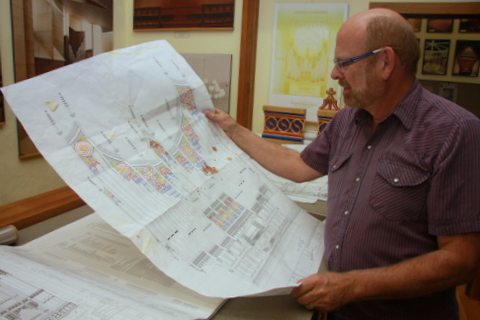
Lynn Dobson designs grand pipe organs that grace churches in small towns like Lake City, Iowa, to cathedrals in New York City.
The barn also housed stock cattle. Dobson will never forget the little bull calf that had to be bucket fed after its mother died. “He had always been so gentle, but one night he decided to pin me against the barn. His horns pushed into the wall and his head was right against me. I never had to feed him again after that.”
Other activities inside the barn were much less threatening. Dobson enjoyed playing in the barn with his sisters and building forts in the straw bales. Sometimes he climbed the ladder that extended to the peak of the roof. “I’d catch little pigeons and try to tame them and raise them as pets,” he said.
The barn was always a hub of activity, Dobson added. While Elmer Dobson phased out of the dairy business in the early 1960s, he continued raising hogs and farrowed sows in the barn. He maintained his livestock operation for many years until he and his wife, Muriel, retired and moved to Lake City in the early 1980s.
After Dobson graduated from Glidden High School in 1967, he studied art at Wayne State College in Nebraska, where he earned his undergraduate degree in 1971. In 1974, he established Dobson Pipe Organ Builders, which recently designed, built and installed a customized pipe organ for the 2014 observance of the 750th anniversary of the founding of Merton College at Oxford, the oldest university in the English-speaking world.
In a way, the inspiration to create this massive organ, known as Opus 91, can be traced to the Carroll County barn that captured Dobson’s interest as a boy. “Barns are grand buildings, and I’m inspired by their magnificent spaces,” he said. “They feel like cathedrals inside.”
Pipe organ builder hits a high note
Note from Darcy: I wrote this feature below on Dobson Pipe Organ builders in 2013.
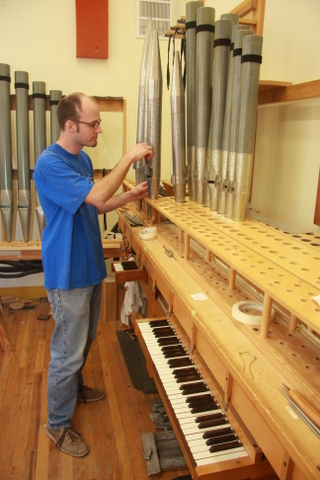
Donald Hobbs, a long-time employee at Dobson Pipe Organ Builders in Lake City, helps create the masterpieces that the company builds for clients worldwide.
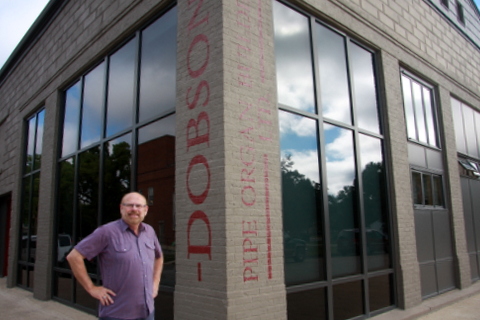
A former John Deere shop has housed Dobson PIpe Organ Builders for years in Lake City, Iowa.
The journey that started on a farm near Lake City has taken an Iowa pipe-organ company international, thanks to the creative vision and entrepreneurial skills of Lynn Dobson.
Dobson Pipe Organ Builders Ltd. designed, built and installed a customized pipe organ for the 2014 observance of the 750th anniversary of the founding of Merton College at Oxford, the oldest university in the English-speaking world. “It’s very unusual for American organ builders to send organs to Europe,” said Dobson, who noted that construction on the organ started in 2011. “It hardly ever happens.”
Made of quarter-sawn white oak from the southern United States, this masterpiece (known as Opus 91) rises 46 feet tall, stretches 26 feet wide, weighs about 16 tons and features hand-carved designs. It also contains nearly 3,000 pipes, which range in size from a drinking straw to a telephone pole.
Opus 91 is a 52-rank mechanical key action organ, which means that there are mechanical links that directly connect each of the keys to valves under the pipes. This kind of organ was created before the advent of electricity and generally is preferred among premier organists.
While this is Dobson Organ’s first overseas project, the company had built 90 organs since 1974 before creating “Opus 91” for Merton College. “We’ve never built the same organ twice,” said Dobson, the company’s president and artistic director.
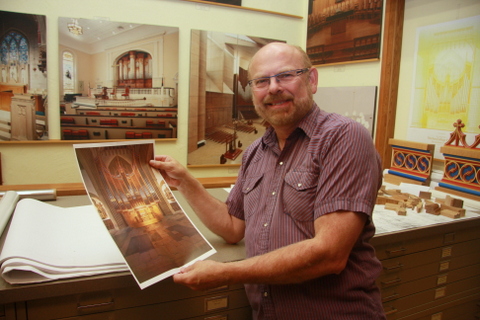 Organ building, like many centuries-old crafts, is becoming increasingly rare. Companies like Dobson’s are even fewer, with an estimated half dozen nationwide. As I look back at the last 40 years of my life, organ building was a good career for me. It gave me a chance to be creative and work with many creative people over the years. I’ve also had the chance to travel and see and do an almost unimaginable variety of things that I realize have made my life a very satisfying one. Dobson grew up on a farm south of Lake City, where he learned about woodworking from his father, a skilled carpenter and cabinetmaker. While attending Nebraska’s Wayne State College, studying art and industrial education, Dobson tinkered with an old, non-working pipe organ in the college administration building. By the time he left, it was playable.
Organ building, like many centuries-old crafts, is becoming increasingly rare. Companies like Dobson’s are even fewer, with an estimated half dozen nationwide. As I look back at the last 40 years of my life, organ building was a good career for me. It gave me a chance to be creative and work with many creative people over the years. I’ve also had the chance to travel and see and do an almost unimaginable variety of things that I realize have made my life a very satisfying one. Dobson grew up on a farm south of Lake City, where he learned about woodworking from his father, a skilled carpenter and cabinetmaker. While attending Nebraska’s Wayne State College, studying art and industrial education, Dobson tinkered with an old, non-working pipe organ in the college administration building. By the time he left, it was playable.
This inspired him to start his own company, which started as a two-man operation and has grown to include 19 skilled employees. They include voicers, pipe makers, cabinetmakers and general organ builders who work in a 1890s-vintage shop located on Lake City’s city square. The company has built about 20 new organs for customers in Iowa, including the Lake City Union Church, Westminster Presbyterian Church in Des Moines and the First Reformed Church in Orange City. The firm has restored an additional 20 organs across Iowa.
Dobson’s reputation has also earned the company acclaim across the United States. Some of the company’s largest projects include the organs at the Cathedral of Our Lady of the Angels in Los Angeles, the Kimmel Center for the Performing Arts in Philadelphia and St Thomas’ Church, New York City.
“I think every day is more exciting,” Dobson said. Even though the economy and a changing cultural and religious climate are great challenges for us in the organ building field the fact is we’re still able to be creative and work with good people. What could be better than that?
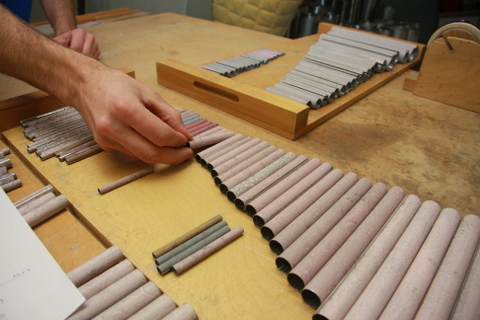
Dobson organ pipes can be as tiny as a pencil to produce the higher notes, and up to 40 feet tall (with pipes weighing 500 pounds) to produce the low notes. Pipes can be made of metal or wood. As shown here, the pipes’ coating, which keeps the solder on the seams, is washed off to expose the shiny pipes once the process is complete.
Want more?
Thanks for stopping by. I invite you to read more of my blog posts if you value intriguing Iowa stories and history, along with Iowa food, agriculture updates, recipes and tips to make you a better communicator.
If you like what you see and want to be notified when I post new stories, be sure to click on the “subscribe to blog updates/newsletter” button at the top of this page, or click here. Feel free to share this with friends and colleagues who might be interested, too.
Also, if you or someone you know could use my writing services (I’m not only Iowa’s storyteller, but a professionally-trained journalist with 20 years of experience), let’s talk. I work with businesses and organizations within Iowa and across the country to unleash the power of great storytelling to define their brand and connect with their audience through clear, compelling blog posts, articles, news releases, feature stories, newsletter articles, social media, video scripts, and photography. Learn more at www.darcymaulsby.com, or e-mail me at yettergirl@yahoo.com.
If you’re hungry for more stories of Iowa history, check out my top-selling “Culinary History of Iowa: Sweet Corn, Pork Tenderloins, Maid-Rites and More” book from The History Press. Also take a look at my latest book, “Dallas County,” and my Calhoun County” book from Arcadia Publishing. Both are filled with vintage photos and compelling stories that showcase he history of small-town and rural Iowa. Order your signed copies today! Iowa postcards are available in my online store, too.
Let’s stay in touch. I’m at darcy@darcymaulsby.com, and yettergirl@yahoo.com.
Talk to you soon!
Darcy
@Copyright 2018 Darcy Maulsby & Co. Blog posts may only be reprinted with permission from Darcy Maulsby.
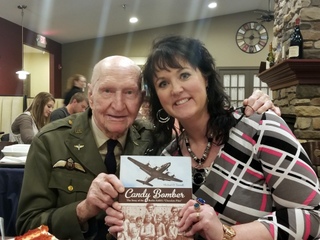
Unwrapping Storytelling Tips from the Candy Bomber
It was a typical evening in Denison, Iowa, when I stopped by the Hillside Grille Steakhouse, but I wasn’t there for the food, and this was no ordinary gathering. I had been invited to meet an authentic American hero, but I was afraid he’d be tired.
Col. Gail Halvorsen, 97, had flown into the Omaha airport on May 2, 2018, with his daughter late that afternoon from his home in the western United States. Turns out I didn’t need to worry about the energy level of this famed World War 2-era pilot. As soon as I sat down at the table near him at the Hillside Grille around 7:45 p.m., the “Candy Bomber” flashed me a big smile.
I knew this was going to be good. I had known it a few days earlier when my friend Vance Lundell, owner of Lundell Plastics in Odebolt, mentioned that the Candy Bomber was coming to western Iowa and invited me to meet the legendary pilot.
To understand the Candy Bomber’s story, let’s go back to 1948. World War 2 was over, but the war’s aftermath continued to ravage Europe. Life was especially grim in Berlin, Germany, which had become a divided city within a divided country.
The Soviets were attempting to cut off Western access to West Berlin, which was located deep inside Soviet-controlled East Germany. Soviet leader Josef Stalin blockaded all ground routes coming in and out of Berlin to cut off West Berliners from all food and other essential supplies. The blockade against the Western Allies threatened to crush a city that was already struggling against starvation. Without outside help, more than 2 million people might die.
In response, the United States and the United Kingdom launched the Berlin Airlift, a humanitarian rescue mission to airdrop food into West Berlin. Halvorsen was part of this effort. Not only did he help provide nourishment to the people of West Berlin, but he also gave the children a reason to hope for a better world—and it also started with two sticks of gum.
Halvorsen, like scores of other Western pilots, had been working 12 to 15 hours a day to deliver food and supplies at Berlin’s Tempelhof Airfield (which is now a public park) like clockwork. But only Halvorsen had an unlikely inspiration that would end up making him famous.
When he encountered some German children lingering at the edge of the air field, he offered two sticks of Wrigley’s chewing gum before departing. When he saw the excitement this small offering generated, the pilot promised to drop candy on his next flight.
When the children asked how they would know which of the huge airplanes was his, Halvorsen said he would wiggle his wings as he approached their position. “Uncle Wiggly Wings” was born.
Halvorsen lived up to his promise and inspired other pilots to donate their candy rations. Halvorsen started dropping chocolate, gum drops and other candy out his plane’s window as a treat for the emaciated Berlin kids often huddled together on the edge of the airfield. He even used spare handkerchiefs to rig up a little parachute for each load so the candy wouldn’t be squashed upon impact. “Operation Vittles” evolved into “Operation Little Vittles” as the Candy Bomber delivered candy and good cheer to the children of the blockaded city.
After newspapers got wind of what was happening, tons of donations of chocolate and other candy donations began pouring in from across America. Halvorsen had not only put a face on the Berlin Airlift, but he bolstered the U.S.’s humanitarian mission during the Cold War by enlisting the American public.
This was no small miracle, considering that Americans who had grown weary of continued food aid for Europe eagerly embraced the opportunity to give candy and chocolate to German children.
From one thoughtful, generous act came a lifelong friendship between the Candy Bomber and the children of Berlin. Halvorsen’s remarkable story is preserved in a number of books, including “Mercedes and the Chocolate Pilot,” a children’s book that tells the true story of a seven-year-old girl named Mercedes who lived in West Berlin during the airlift and still stays in touch with the Candy Bomber.
In fact, the Candy Bomber has been preparing to return to Germany this June for another visit with friends he made all those years ago. Maybe I shouldn’t have been surprised. Nothing seems to slow Halvorsen down—at least not for long. An hour and a half after I had arrived to meet him at the restaurant in Denison a few weeks ago, Halvorsen showed no signs of fatigue, even though it was well past 9 p.m., and he’d been busy giving media interviews and meeting new friends that evening.
When I asked Halvorsen how he was doing, his reply “I’m ready to go!” wasn’t a plea. It was a confident, spirited answer conveying his zest for life and his love of adventure. His Iowa adventure continue the next morning when he spoke to students at the school in Odebolt before flying home.
I admit—I’ve been a little surprised to learn that many Iowans aren’t familiar with the Candy Bomber, even though his story has been shared widely. I asked Halvorsen his thoughts on the importance of teaching history. “It’s important to remember, isn’t it? Thanks for teaching the youth.”
I want younger generations to know that thanks to Halvorsen’s efforts and those of his fellow pilots, the Allies held on to West Berlin and maintained support back home for the Berlin Airlift. By 1949, the Soviets lifted the blockade, and land delivery of food resumed.
It’s not just important, but essential, to share the stories of leaders like Halvorsen who prove how one person can make a positive difference and change the course of history. You just never know how much impact your story can have, not just now, but for generations to come. I’ll never forget one final insight my new friend, the Candy Bomber, shared that night in Denison. “The small things you do can turn into great things.”
Want more?
Thanks for stopping by. I invite you to read more of my blog posts if you value intriguing Iowa stories and history, along with Iowa food, agriculture updates, recipes and tips to make you a better communicator.
If you like what you see and want to be notified when I post new stories, be sure to click on the “subscribe to blog updates/newsletter” button at the top of this page, or click here. Feel free to share this with friends and colleagues who might be interested, too.
Also, if you or someone you know could use my writing services (I’m not only Iowa’s storyteller, but a professionally-trained journalist with 20 years of experience), let’s talk. I work with businesses and organizations within Iowa and across the country to unleash the power of great storytelling to define their brand and connect with their audience through clear, compelling blog posts, articles, news releases, feature stories, newsletter articles, social media, video scripts, and photography. Learn more at www.darcymaulsby.com, or e-mail me at yettergirl@yahoo.com.
If you’re hungry for more stories of Iowa history, check out my top-selling “Culinary History of Iowa: Sweet Corn, Pork Tenderloins, Maid-Rites and More” book from The History Press. Also take a look at my latest book, “Dallas County,” and my Calhoun County” book from Arcadia Publishing. Both are filled with vintage photos and compelling stories that showcase he history of small-town and rural Iowa. Order your signed copies today! Iowa postcards are available in my online store, too.
Let’s stay in touch. I’m at darcy@darcymaulsby.com, and yettergirl@yahoo.com.
Talk to you soon!
Darcy
@Copyright 2018 Darcy Maulsby & Co. Blog posts may only be reprinted with permission from Darcy Maulsby.
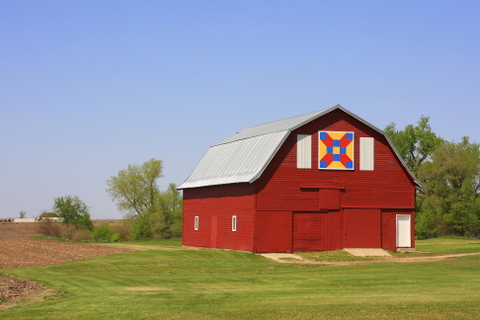
Pieced Together: Barn Quilt Documentary Features Iowa Stories
Barn quilts have become a folk-art phenomenon in Iowa in the past 15 years, turning up not only on barns, but mailboxes, gardens, buildings in town and more. But there was a time not that long ago when no one had ever heard of a barn quilt—not until Donna Sue Groves wanted to add a little color to her corner of the world.
Her story—and those of barn quilt enthusiasts in places like Sac County—inspired the 53-minute documentary “Pieced Together,” which filmmaker Julianne Donofrio showed in Sac City to a full house at the First Christian Church on the evening of Sept. 24, 2018.
“A lot of people don’t know where barn quilts came from,” said Donofrio, who is from the New York City/Washington, D.C. area. “I want people to know Donna Sue’s story.”
The story, which includes many barn quilts across Iowa, began in 1989 when Groves’ family bought a farm in Adams County, Ohio, near the Ohio River Valley at the foothills of the Appalachian Mountains. Groves made a casual remark to her mother, Nina Maxine Groves, about an uninspiring, time-worn tobacco barn on the farm.
“It was the ugliest barn I’d ever seen,” Groves said in “Pieced Together.” “I joked to my mother, ‘I’ll paint you a quilt square on it someday.’”
Game inspires a lifelong love of barns
Groves’ interest in barns dates back to her childhood. When her family would visit Groves’ grandmother in Roane County, West Virginia, Groves’ mother invented a car game to keep Groves and her brother quiet.
“You couldn’t play the typical license plate game when you’re traveling the back roads of West Virginia, because all you saw were West Virginia license plates,” Groves said. “Mother created a car game where we counted barns.”
Some barns were worth two points, while others were worth three points. If a barn had outdoor advertising, like “Chew Mail Pouch” or “RC Cola,” players got a 10-point bonus if they could read the lettering. Red barns also earned higher points. The chance to earn even more points awaited when the family’s wider travels took them past Pennsylvania Dutch barns with colorful, geometric hex signs.
The game led to discussions and questions about the barns, such as who built the barns, and for what purpose. Groves enjoyed these conversational teaching moments. “I looked forward to seeing barns,” she said.
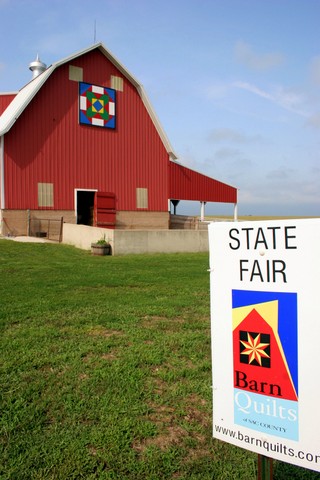
Sac County Iowa barn quilt
Creating a clothesline of quilts across America
This history eventually inspired Groves’ involvement with the first barn quilt square, an Ohio Star pattern, which was created in October 2001 and displayed in Adams County, Ohio. This small gesture triggered a ripple effect across North America.
“If we didn’t pick up on this idea, someone else would,” said Groves’ mother, Maxine, who was featured in “Pieced Together.”
As more people wanted to create barn quilts, Groves and her fellow volunteers quickly learned that painting barn quilts directly onto barns didn’t work too well, but painted plywood squares offered a much better option.
Why stop with just a few barn quilts, though? “A trail of barn quilts could bring tourists here to see all the wonderful things Adams County offers,” noted Groves, who has served as a field representative for the Ohio Arts Council. “Then they’d stay in our bed-and-breakfasts and motels and eat at our restaurants.”
These opportunities for economic development, combined with the visual appeal of barn quilts, soon inspired a “clothesline of quilts” across America. Residents of an adjoining county, Brown County, Ohio, loved Groves’ idea and asked how to get involved. Folks in Tennessee read an article about the Ohio barn quilt project, called Groves and wanted to know how to do a similar project in their area. Grundy County, Iowa, also got involved in 2003, followed by Sac County.
When Sue Peyton and her family from rural Sac City heard about barn quilts, it seemed like a good fit for her son, Kevin, who was in high school and looking for a project he could use as a 4-H leadership project and a Herbert Hoover Uncommon Student Award project.
“I immediately fell in love with the project when I heard about it,” Sue Peyton said. “Barns and barn quilts are such a natural fit.”
The Peytons coordinated the construction and painting of Sac County’s first barn quilts in the summer of 2005. While some people weren’t quite sure what to make of the new barn quilts that started appearing on barns and corncribs around the county, the concept caught on quickly. “We hoped to get 20 barn quilts,” said Sue Peyton, who added that Sac County boasted 55 barn quilts within two years of the start of the project.
“I’ve seen a lot of quilt trails, and you embraced this early on and have done a tremendous job,” said Donofrio as she chatted with audience members in Sac City following her documentary.
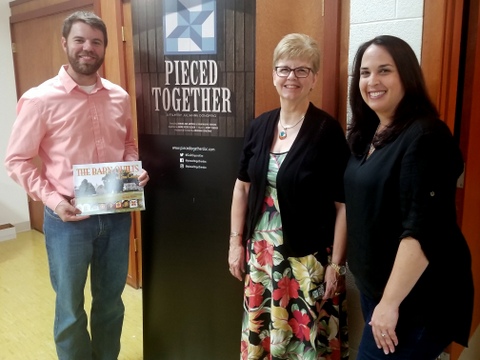
Sac County barn quilt proponents Kevin Peyton and his mother, Sue, (center) welcomed filmmaker Julianne Donofrio, who showed her 53-minute documentary “Pieced Together” in Sac City to a full house at the First Christian Church in September 2018.
“We’re here to stay”
Anywhere there’s a barn quilt trail, every square tells a story. Also, there’s no right or wrong way to create a barn quilt. “Barn quilts have a storied history as complex and diverse as the quilt patterns themselves,” Kevin Peyton said.
Consider the Double Aster barn quilt pattern on the Hogue family’s 1943 barn north of Odebolt. The pastel-colored design complements the family’s Prairie Pedlar Gardens business. Owner Jane Hogue, who served on the original Sac County Barn Quilt Committee, enjoyed watching the “Pieced Together” documentary.
“It was fun to see the snippets of Sac County’s barn quilts in the film,” she said. “We’re proud to be part of Sac County’s barn quilt project. With our gardens and tourism, it’s a win-win.”
Sac County proves that barn quilts offer an effective way to help save barns, promote rural tourism and boost economic development, Sue Peyton added. She cited the vintage barn at the Rustic River Winery and Vineyard north of Lake View, for example. It has been remodeled not only into a winery, but a venue where people can host parties and other gatherings.
As the history of the barn quilt phenomenon is preserved through projects like “Pieced Together,” barn quilts are being praised as one of the greatest community art projects ever created. While there are barn quilt trails in 42 states, there is no national barn quilt organization, by design. Creating barn quilts at the local allows local people to make their mark, share their history and establish a legacy. “It’s so adaptable—that’s the beauty of it,” Groves said.
Above all, barn quilts inspire people to view rural communities in a new way. “Barn quilts prompt a question that starts a discussion,” noted a speaker in the “Pieced Together” documentary. “It’s a statement that, ‘We’re here, and we’re here to stay.’”
Barn quilts also prove the power of one person from an isolated rural county to inspire a vision that has touched an entire nation. “As times get harder, we forget how to dream,” said Groves, a cancer survivor. “I like to think the barn quilt trails allow people to dream.”
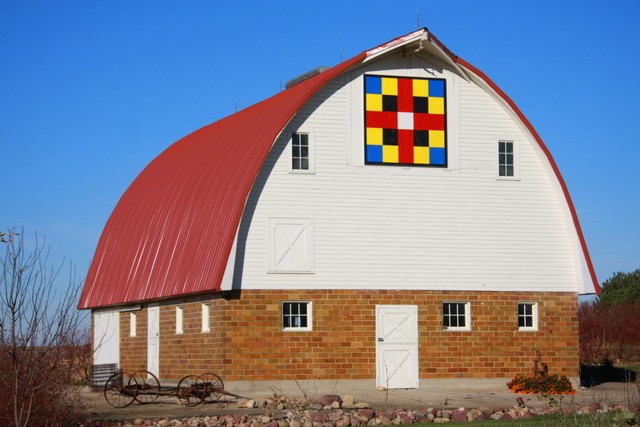
Sac County barn quilt near Early, Iowa
Want more?
Thanks for stopping by. I invite you to read more of my blog posts if you value intriguing Iowa stories and history, along with Iowa food, agriculture updates, recipes and tips to make you a better communicator.
If you like what you see and want to be notified when I post new stories, be sure to click on the “subscribe to blog updates/newsletter” button at the top of this page, or click here. Feel free to share this with friends and colleagues who might be interested, too.
Also, if you or someone you know could use my writing services (I’m not only Iowa’s storyteller, but a professionally-trained journalist with 20 years of experience), let’s talk. I work with businesses and organizations within Iowa and across the country to unleash the power of great storytelling to define their brand and connect with their audience through clear, compelling blog posts, articles, news releases, feature stories, newsletter articles, social media, video scripts, and photography. Learn more at www.darcymaulsby.com, or e-mail me at yettergirl@yahoo.com.
If you’re hungry for more stories of Iowa history, check out my top-selling “Culinary History of Iowa: Sweet Corn, Pork Tenderloins, Maid-Rites and More” book from The History Press. Also take a look at my latest book, “Dallas County,” and my Calhoun County” book from Arcadia Publishing. Both are filled with vintage photos and compelling stories that showcase he history of small-town and rural Iowa. Order your signed copies today! Iowa postcards are available in my online store, too.
Let’s stay in touch. I’m at darcy@darcymaulsby.com, and yettergirl@yahoo.com.
Talk to you soon!
Darcy
@Copyright 2018 Darcy Maulsby & Co. Blog posts may only be reprinted with permission from Darcy Maulsby.

Are You Telling a Horror Story of Your Business?
Not sure how to tell your company’s story? I’d recommend staying away from a tactic a manufacturing company here in Iowa used recently when a group of local students toured the facility. Instead of sharing what makes the company unique and why it’s a great place to the work, the company’s tour guides detailed the many ways employees can earn demerits. If an employee gets a certain number of points, he or she can get fired.
While it’s essential to have high standards, the horror story this company chose to share painted a negative, grim view of this company. If I were a student on this tour, I’d definitely remember this place–but not in a good way. Would I want to work here? No way.
Instead of focusing on the negative, especially with people who are just becoming acquainted with your company, I recommend sharing the positive with your marketing and storytelling. Show how your business practices and company culture work together to help employees provide valuable products or services that make customers’ lives better. In the case of the students at the manufacturing plant, remember that these are future job seekers. Put yourself in their place. Share stories that help them discover career opportunities with companies like yours. Explain the education and training needed to succeed here. Encourage them envision the advantages of living and working in their hometown–at your company.
Need help identifying these kinds of stories and the best ways to share them? Let’s talk. #storytelling #manufacturing #business
Want more?
Thanks for stopping by. I invite you to read more of my blog posts if you value intriguing Iowa stories and history, along with Iowa food, agriculture updates, recipes and tips to make you a better communicator.
If you like what you see and want to be notified when I post new stories, be sure to click on the “subscribe to blog updates/newsletter” button at the top of this page, or click here. Feel free to share this with friends and colleagues who might be interested, too.
Also, if you or someone you know could use my writing services (I’m not only Iowa’s storyteller, but a professionally-trained journalist with 20 years of experience), let’s talk. I work with businesses and organizations within Iowa and across the country to unleash the power of great storytelling to define their brand and connect with their audience through clear, compelling blog posts, articles, news releases, feature stories, newsletter articles, social media, video scripts, and photography. Learn more at www.darcymaulsby.com, or e-mail me at yettergirl@yahoo.com.
If you’re hungry for more stories of Iowa history, check out my top-selling “Culinary History of Iowa: Sweet Corn, Pork Tenderloins, Maid-Rites and More” book from The History Press. Also take a look at my latest book, “Dallas County,” and my Calhoun County” book from Arcadia Publishing. Both are filled with vintage photos and compelling stories that showcase he history of small-town and rural Iowa. Order your signed copies today! Iowa postcards are available in my online store, too.
Let’s stay in touch. I’m at darcy@darcymaulsby.com, and yettergirl@yahoo.com.
Talk to you soon!
Darcy
@Copyright 2018 Darcy Maulsby & Co. Blog posts may only be reprinted with permission from Darcy Maulsby.
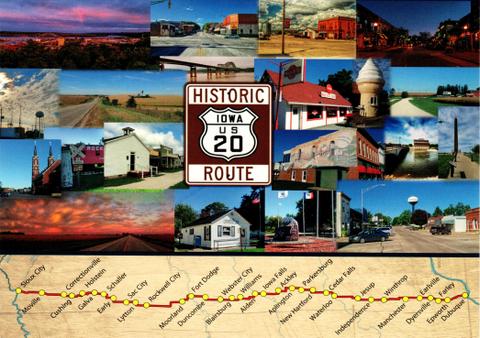
It’s Time to Be 20 Again: Take a Road Trip on Historic Highway 20
It’s a quest that’s decades in the making. When hundreds of people gathered in Holstein on October 19, 2018, for a ribbon-cutting celebrating the completion of U.S. Highway 20 as a four-lane thoroughfare across Iowa, the focus on the future was intertwined with the history of this remarkable road–which offers the perfect route for a road trip.
“Highway 20 is the longest highway in America, spanning 3,365 miles from Boston, Massachusetts, to Newport, Oregon,” said Bryan Farr, founder and president of non-profit Historic US Route 20 Association, which promotes travel along the original 1926 alignment of US Route 20. “Modern travelers aren’t always aware of Highway 20. We want to make it a tourist destination like Route 66.”
Highway 20 passes through 12 states, including Massachusetts, New York, Pennsylvania, Ohio, Indiana, Illinois, Iowa, Nebraska, Wyoming, Montana, Idaho and Oregon. “A lot of interesting things have happened along the highway, from Puritan New England to the Wild West,” said Farr, who shared stories of history, presidents, natural wonders, quirky roadside attractions and more connected to Highway 20 during his program “Historic U.S. Route 20: A Journey Across America’s Longest Highway” on Oct. 14 to a large crowd at the Sioux City Lewis & Clark Interpretive Center.
But first things first—is 20 a highway or a route?
“It depends on where you’re from,” said Farr, who grew up in the Finger Lakes region of New York state and now lives in Chester, Massachusetts. “If you’re from Massachusetts, New York or Pennsylvania, you pronounce it ‘Root’ 20. If you’re from Ohio, Indiana or Illinois you say, ‘Route 20.’ If you’re west of the Mississippi River, it’s Highway 20.”
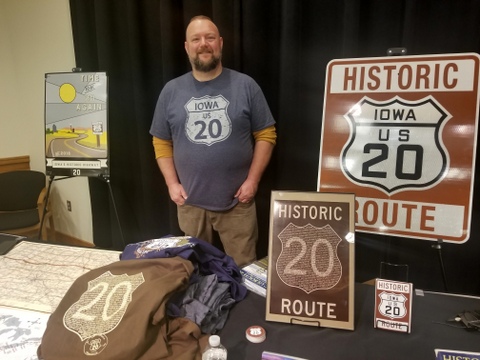
Bryan Farr is the founder and president of non-profit Historic US Route 20 Association, which promotes travel along the original 1926 alignment of US Route 20.
History happened here
The remarkable history of Highway 20 started with the passing of the Federal Highway Act of 1921, which appropriated $75 million for road construction throughout the country. The roads that would become Highway 20 were officially designated during the summer of 1925, with the original alignment of the highway taking shape in 1926.
Creating the modern, efficient, paved, four-lane highway travelers enjoy across Iowa today, however, took decades to create, Farr said. The road was often re-aligned throughout its history, and much of it was gravel for part of the highway’s history. “There are still little sections of the 1926 alignment of Highway 20 outside of Early and Fort Dodge that still are gravel,” Farr noted.
Speaking of Fort Dodge, this Highway 20 city has an unforgettable connection to Cardiff, New York, another Highway 20 town where one of the greatest hoaxes of the nineteenth century took place.
It all started when Stubb Newell of Cardiff, New York, needed a new well. On Oct. 16, 1869, Newell directed two well diggers to a spot he selected behind his barn. The men dug 3 feet and hit something solid. They uncovered a huge stone foot. As they dug more, an entire body of a man emerged. Two days later, a large tent was placed over the 10-foot stone man and crowds of nearly 200 to 500 people a day paid 50 cents to see this giant. Scientists, philosophers and the clergy attended and were challenged in their beliefs, noted the Historic US Route 20 Association website.
Legendary showman P.T. Barnum offered $60,000 for the giant but was turned down. Soon, however, the hoax came to light when people recalled a man named George Hull (a cousin of Newell) had visited a gypsum mine at Fort Dodge in 1868. He commissioned a 5-ton block to be used to carve a statue of Abraham Lincoln. The block of gypsum was shipped to Chicago and carved into this giant man. The carving’s surface was treated with acids and picked at with needles to give it an antiquated look. It was then shipped and buried in New York.
Today, the giant rests at the Farmers’ Museum in Cooperstown, New York. In 1969, a replica was created from the same gypsum quarry and is on display at the Fort Museum in Fort Dodge.
These types of stories offer a unique perspective of Highway 20, which Farr has traveled from coast to coast. “I want to bring people back into small town America, to shop locally and support local businesses to boost economic development in communities that may be bypassed by interstate highways or other more popular routes.”
Gaining a new perspective of Highway 20
Highway 20 is also distinguished by a number of other noteworthy distinctions, including:
• Ties to some of America’s major and mid-sized cities. Highway 20 includes Boston, Buffalo, Cleveland, Chicago and Boise.
• A connection to five presidents. “Highway 20 is a presidential route,” said Farr, citing George Washington as well as Abraham Lincoln, whose famous debates with political rival Stephen Douglas took place in Freeport, Illinois. Highway 20 is also connected Galena, Illinois, where President Ulysses S. Grant had a home. In northern Ohio, Highway 20 passes through Freemont, home of President Rutherford B. Hayes, who served from 1877 to 1881, oversaw the end of Reconstruction and attempted to reconcile the divisions left from the Civil War. Cleveland, Ohio, honors President James Garfield, who was elected president in 1881 but whose service was cut short after 200 days in office when he was assassinated and later died on September 19, 1881.
• The women’s movement organized along the future Highway 20. The Seneca Falls Convention was the first women’s rights convention in the United States. Held in July 1848 in Seneca Falls, New York, the meeting launched the women’s suffrage movement, which more than seven decades later ensured women the right to vote.
• Highway 20 name is more than just name. In 1925, a system of numbered highways debuted in America to replace the jumbled, confusing mess of named auto trails. “Routes with a zero at the end, like Route 20, were transcontinental routes,” said Farr, author of the book “Historic Route 20: A Journey Across America’s Longest Highway.” “Also, east-west routes have even numbers, while north-south routes have odd numbers.”
• Iowa attractions abound along Highway 20. Spanning roughly 330 miles across Iowa from Dubuque to Sioux City, Highway 20 offers plenty to see and do, Farr said. A few options include Dyersville, home of the famous Field of Dreams movie site, the National Farm Toy Museum and the Basilica of St. Francis Xavier; Independence, home of the Heartland Acres Agribition Center, which connects visitors to the past, present and future of Iowa agriculture; Sac County, with its famous barn quilt trail and world’s largest popcorn ball in Sac City and Sioux City, with its rich history related to the journey of the Lewis and Clark expedition nearly 250 years ago.
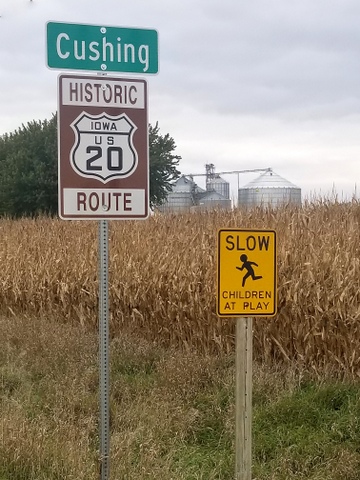
While the first Historic Route 20 sign was placed in Painesville, Ohio, in 2014, Cushing became the first Iowa community to display one of the distinctive signs. This sign greets visitors as they enter the small Woodbury County town from the east on the old route of Highway 20.
It’s interesting to note that bypasses started being built along Highway 20 almost from the start, starting in Massachusetts in the late 1920s. By the 1950s, bypasses in Iowa rerouted Highway 20 out of Farley in eastern Iowa. The trend hasn’t stopped since then. In recent years, communities along historic Highway 20 have been installing signs to denote their unique place along the route. While the first Historic Route 20 sign was placed in Painesville, Ohio, in 2014, Cushing became the first Iowa community to display one of the distinctive signs. This sign greets visitors as they enter the small Woodbury County town from the east on the old route of Highway 20.
While efficient transportation has its place, Farr encourages travelers venture off the interstates and four-lane Highway 20, explore the nearby towns and rural areas and see some the best of America. “Highway 20 is like a companion,” said Farr, who is promoting the new slogan “It’s time to be 20 again.” “This road will take you home.”
Want more?
Thanks for stopping by. I invite you to read more of my blog posts if you value intriguing Iowa stories and history, along with Iowa food, agriculture updates, recipes and tips to make you a better communicator.
If you like what you see and want to be notified when I post new stories, be sure to click on the “subscribe to blog updates/newsletter” button at the top of this page, or click here. Feel free to share this with friends and colleagues who might be interested, too.
Also, if you or someone you know could use my writing services (I’m not only Iowa’s storyteller, but a professionally-trained journalist with 20 years of experience), let’s talk. I work with businesses and organizations within Iowa and across the country to unleash the power of great storytelling to define their brand and connect with their audience through clear, compelling blog posts, articles, news releases, feature stories, newsletter articles, social media, video scripts, and photography. Learn more at www.darcymaulsby.com, or e-mail me at yettergirl@yahoo.com.
If you’re hungry for more stories of Iowa history, check out my top-selling “Culinary History of Iowa: Sweet Corn, Pork Tenderloins, Maid-Rites and More” book from The History Press. Also take a look at my latest book, “Dallas County,” and my Calhoun County” book from Arcadia Publishing. Both are filled with vintage photos and compelling stories that showcase he history of small-town and rural Iowa. Order your signed copies today! Iowa postcards are available in my online store, too.
Let’s stay in touch. I’m at darcy@darcymaulsby.com, and yettergirl@yahoo.com.
Talk to you soon!
Darcy
@Copyright 2018 Darcy Maulsby & Co. Blog posts may only be reprinted with permission from Darcy Maulsby.


